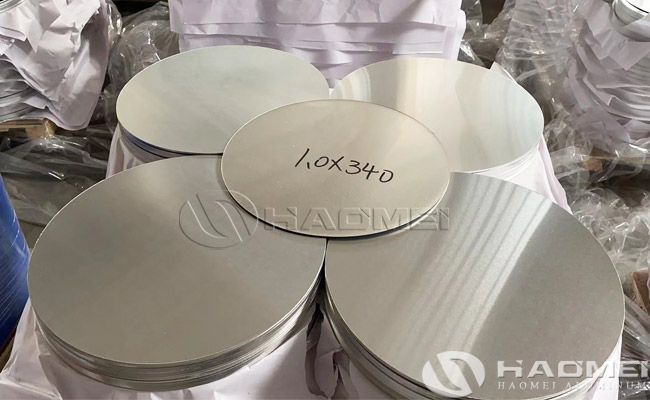Aluminum circle discs for utensils typically refer to circular sheets made of aluminum, it is widely used in kitchen utensils production due to its lightweight, corrosion resistance and good thermal conductivity. The quality of aluminum circle discs used in kitchen utensils manufacturing must meet multiple requirements, including chemical composition, dimensional accuracy, mechanical properties, surface quality, manufacturing process and food-grade safety.
1. Chemical Composition Standards
- Aluminum content:
The main component of aluminum circle discs is aluminum. Taking the common 1060 aluminum disc as an example, the aluminum content needs to be around 99.60%.
- Trace element control:
The content of iron (Fe) must be limited to below 0.35%, manganese (Mn) to 0.03%, silicon (Si) to 0.25%, copper (Cu) to 0.05%, magnesium (Mg) to 0.03%, zinc (Zn) to 0.05%, and titanium (Ti) to 0.03%. Exceeding these trace element limits will significantly affect the performance of the aluminum discs. For example, excessive iron content will lead to decreased material toughness, making it prone to deformation during subsequent processing and forming.
2. Dimensional Accuracy Standards
- Diameter and thickness range:
The common diameter range for aluminum discs is 100mm to 1000mm, and the thickness varies from 1mm to 20mm.
- Tolerance control:
For applications requiring high precision, the diameter tolerance must be controlled within ±0.1mm, and the thickness tolerance within ±0.05mm. For general decorative applications, the dimensional tolerance range can be appropriately relaxed, but the installation and usage effects must still be guaranteed.
3. Mechanical Performance Standards
- Tensile strength:
Taking 1060 aluminum discs as an example, the tensile strength is typically in the range of 55-95MPa. If the tensile strength is too low (e.g., 40MPa), it is prone to frequent breakage during the stamping process of the equipment casing, leading to material waste and production delays.
- Yield strength and elongation:
Yield strength should be between 15-45 MPa, and elongation between 5%-30%. Different applications have different requirements for mechanical properties. For example, the aerospace field has extremely high requirements for the strength and toughness of aluminum discs, requiring strict control of all indicators within a very small error range.
4. Surface Quality Standards
- Surface flatness:
The surface of the aluminum circle disc must be flat, free from obvious scratches, pinholes, bubbles, and other defects. For example, if aluminum discs purchased by aluminum craft manufacturers have minor scratches on their surface, these scratches will become very noticeable after polishing, coloring, and other subsequent processes, severely affecting the aesthetics of the crafts.
- Oxide layer uniformity:
The oxide layer on the surface of the aluminum disc circle must be uniform, as this relates to its corrosion resistance. If the oxide layer on the surface of aluminum discs used for outdoor decoration is uneven, corrosion and rust are likely to occur under wind, sun and rain.
- Surface treatment:
For aluminum discs with high surface quality requirements, additional treatments such as anodizing, electroplating, and spraying may be necessary to further improve their corrosion resistance and decorative properties. For example, high-end architectural decorative aluminum discs, after anodizing, form a hard, dense oxide film on their surface, which is not only corrosion-resistant but also displays various beautiful colors and lusters.
5. Production Process Standards
- Smelting stage:
Melting temperature requires precise control. Excessive temperature increases the gas absorption of the molten aluminum, easily creating porosity in the subsequently formed aluminum discs; insufficient temperature results in poor fluidity of the molten aluminum, potentially leading to uneven composition.
- Casting stage:
Casting speed, cooling rate, and other parameters require precise control. Excessive casting speed can easily cause shrinkage cavities inside the aluminum discs.
- Rolling stage:
Rolling force, rolling speed, and the surface condition of the rolls all affect the thickness uniformity, surface smoothness, and internal structure of the aluminum discs. Wear on the roll surface will result in textured surfaces on the rolled aluminum discs.
- Advanced processes:
Using continuous casting and rolling processes to produce aluminum discs can improve production efficiency and product quality, but it places higher demands on equipment and process control. From raw material selection and smelting process monitoring to casting and rolling parameter adjustment, every step must be strictly implemented according to standards.
6. Food-Grade Safety Standards (for food contact cookware)
- Material requirements:
Aluminum and aluminum alloy raw materials used in the production of food contact products must comply with relevant national or industry standards. The alloy composition should be stable and controllable, and raw materials containing excessive levels of harmful impurities (such as arsenic, antimony, barium, cadmium, chromium (VI), lead, mercury, selenium, etc.) are prohibited.
- Surface treatment layer requirements:
Surface treatment layers (such as anodized films, coatings, etc.) must be firm and uniform, without peeling or cracking. The chemicals used in surface treatment must meet food safety requirements and must not migrate harmful substances into food.
Aluminum circle discs meeting the above quality requirements are often used to make the bottoms of cookware to achieve rapid and even heating. Aluminum baking pans are lightweight and conduct heat quickly, making them suitable for baking. Some aluminum tableware and cookware also use aluminum discs as a material.